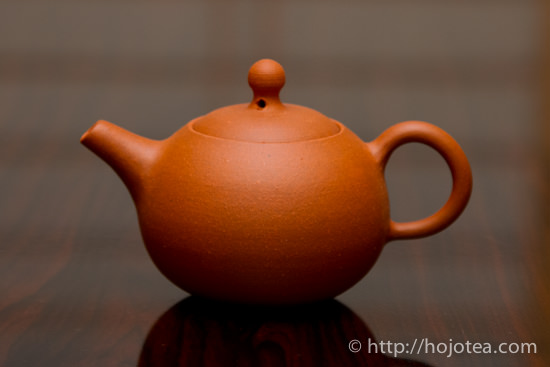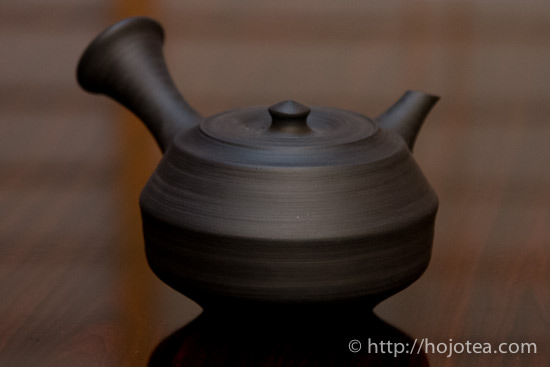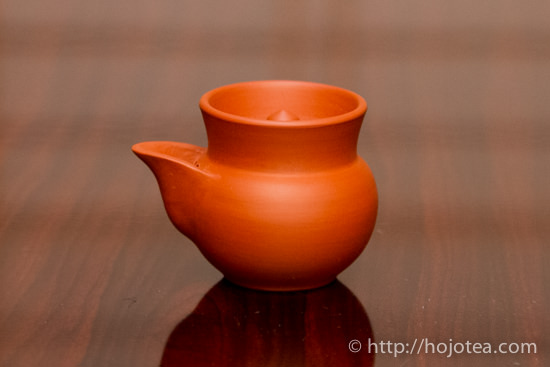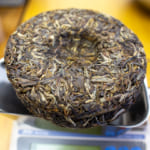- HOME >
- Featured Articles
Do we have to use one tea pot for one tea?
- [2013.03.20] Posted By Akira Hojo
It often comes to the discussion whether or not we should use one teapot for one tea. I would like to share some knowledge based on my first hands experience.
It is the mineral that you need to care
Flavor of tea disappear fast as it get oxidized
1. Flavor of tea comes from organic substance. When we brew tea using a clay tea pot, its flavour may remain for short period of time. Once organic substance is oxidized, flavor will then disappear from the clay. In other words, organic substance present in tea is not our main concern.
Mineral keeps growing on the inside
2. Minerals contribute to after taste. Mineral is very stable. For example, the salt found in the mountain remains unchanged and never deteriorated even if it is kept for thousands of year.
Therefore, we need to pay attention to minerals and not the flavour of tea. When we brew tea in a teapot, both tea and water also supply minerals. As such, I determine three sources of minerals as follow:-
A. Tea
B. Water
C. Clay
Both tea and water is the source of mineral
If the clay and water is the right quality, we are supposed to experimence more “after taste” than that of water by itself.
- B + A
- B + C
- B + A + C
Right clay increases the after taste of water
The combination of clay + water gives stronger after taste than just water by itself. This is due to the interaction of minerals from clay with water molecules. If a teapot is only used with water over and over again for many months, minerals from water will accumulate on the surface of clay and form a layer of “scale”. Scale consists of not only calcium carbonate, but also various kinds of trace minerals such as iron, magnesium, zinc and etc. Each type of water used contributes to the mineral composition of the scale. In a long run, minerals accumulate on the surface of clay and form a solid layer.
Teapot performs better even if it is just seasoned by water
A teapot treated with water everyday for 1 month produce smoother taste.
We did conduct the following experiment.We poured water into clay teapot everyday and continue more than a month. A month later, we tasted the water from the clay tea pot, it is definitely different compare to the taste of water from a new tea pot of the same clay. The clay that has been treated with water for a month gives stronger after taste than new clay. This fact implies that it is very important to stick to the same type of water when brewing tea.
Parenthetically, the after taste of No.2 (B+A) must be stronger than water (B). If the combination between clay and water is not correct, the after taste on water is stronger than No.2. This could be happened if the clay is not suitable. Hence, before start brewing tea, please conduct the following experiment and make sure that the intensity of after taste is stronger than control.
The minerals from tea also accumulates on the inside of clay
Tea is the additional source of minerals besides water. If we keep brewing the same tea using the same water and clay, a complex of minerals will be formed on the surface of clay. The minerals come from both water and tea leaves. If teapot is used for only one type of tea, it will consistently build-up the complex of minerals. Later on the intensity of after taste on No.2 becomes equal to No.3. If you just run through water in your teapot, you will enjoy the same intensity of after taste as when tea is brewed. Because teapot is coated with the solid layer of minerals supplied from both water and tea leaves. At this point, if you brew tea using this tea pot, the intensity of after taste is supposed to be even stronger than No.3. This is the theory of how the performance of teapot is improved.
It is not very practical to stick to one teapot for one tea
After all, it is very ideal to stick to one teapot for one type of tea. However, most importantly you must stick to the same type of water. I usually drink more than 100 types of tea in a month. Should I use more than 100 teapots? It seems not very practical for me.
Recommendation
As a conclusion, for each type of clay teapot, I will only use it for the type of tea which gives a stronger after taste when it is combined with the clay. If I keep changing the type of tea to brew in one teapot, the performance of clay may not be upgraded much, although the performance of clay can be improved thanks to the minerals from the water. If you wish to share the same teapot for a few different types of tea, please select based on the same origin and not the category of tea. Tea should be grouped based on its source, such as “Phoenix tea”, “Wuyi tea”, “Taiwan Oolong”, “Sencha from yabukita”, “Sencha from zairai”, “Yunnan tea” and etc.
Related Articles
How to get the latest update on HOJO?
1. Follow Twitter, 2. Click "Like" on Facebook, and 3. Subscribe in newsletter. You can have the latest tea news from HOJO.
 Subscribe the Newsletter to enjoy the privileges
Subscribe the Newsletter to enjoy the privileges- You may receive a free sample upon purchase, or you may have the priority to purchase special products. So please remember to subscribe our newsletter as well as the social network.
- New Arrival of Akitsu Mumyoi and Nosaka Rough Clay Teapot
- A wide selection of teaware by Watanabe Tozo, a Sado-based artist of Mumyoi-yaki, has just arrived. This time, …
- Mang Fei Ripe Pu-erh Tea 2023 – Small-Batch Production from a Renowned Region
- Mang Fei Ripe Pu-erh Tea 2023 is now available. This is one of the highest-quality ripe pu-erh teas among our …
NEW ARTICLES
 Development of Firewood Roasted Hojicha Using Naturally Grown Tea from Yunnan
Development of Firewood Roasted Hojicha Using Naturally Grown Tea from Yunnan- We are currently staying in Yunnan Province for tea production. As the season nears its end, tea trees with pa …
 Exploring the Food Culture of Yunnan: Where Minority and Sichuan Cuisines Meet
Exploring the Food Culture of Yunnan: Where Minority and Sichuan Cuisines Meet- We are currently staying long-term in Yunnan Province for spring tea production. On rainy days or when there i …
 New Arrival of Akitsu Mumyoi and Nosaka Rough Clay Teapot
New Arrival of Akitsu Mumyoi and Nosaka Rough Clay Teapot- A wide selection of teaware by Watanabe Tozo, a Sado-based artist of Mumyoi-yaki, has just arrived. This time, …
 Managing Yunnan White Tea — Insights from the Field
Managing Yunnan White Tea — Insights from the Field- Since March 25, we have been in Yunnan Province, fully engaged in the production of white tea. In this column, …
 Mang Fei Ripe Pu-erh Tea 2023 – Small-Batch Production from a Renowned Region
Mang Fei Ripe Pu-erh Tea 2023 – Small-Batch Production from a Renowned Region- Mang Fei Ripe Pu-erh Tea 2023 is now available. This is one of the highest-quality ripe pu-erh teas among our …
 Yunnan Tea Trends 2025: Insights from the Fields
Yunnan Tea Trends 2025: Insights from the Fields- Since March 25, we have been in Yunnan Province. We will stay here until May to conduct tea production, packin …
 Why Do Some Teas Taste Astringent? Exploring the Causes and Mechanisms of Astringency
Why Do Some Teas Taste Astringent? Exploring the Causes and Mechanisms of Astringency- Tea can range from having no noticeable astringency to possessing a very strong one. What causes this astringe …
 The Impact of Heat Sources on Tea Flavor
The Impact of Heat Sources on Tea Flavor- It is widely recognized that the material of a kettle plays an important role in shaping the taste of water fo …
 New Release of Tang Li Shan Ripe Pu-erh Tea 2023
New Release of Tang Li Shan Ripe Pu-erh Tea 2023- We have released the 2023 edition of Tang Li Shan Ripe Pu-erh Tea. Tang Li Shan refers to a mountain located o …
 The New Release of Dong Shan Raw Pu-erh Tea 2023 and Jasmine Silver Needle
The New Release of Dong Shan Raw Pu-erh Tea 2023 and Jasmine Silver Needle- We have released Dong Shan Raw Pu-erh Tea 2023 and Jasmine Silver Needle. Dong Shan Raw Pu-erh Tea 2023 We hav …
Category
- New Arrival at HOJO Online Shop
- Featured Articles
- Newsletter
- Types of Tea
- Origin of Tea
- Teapot and Tea Equipment
- Tea Column
- How to enjoy tea
- Tea Processing
- How to choose quality tea
- Tea constituents and functional effect
- Safety of Tea
- Foods
- Tea Business Operation
- Hobby and Outdoor Activity
- Ranking of Tea
- Video
- FAQ
- Media Release
Profile

- AKIRA HOJO
- I invite you to experience my tea selections.I was born in Nagano, Japan. In university, I studied agricultural chemistry, and I have the master degree in food science. I worked in Japanese food industry for 10 years. I involved in R&D, QC and QA. As a factory manager, I implemented ISO9000 series and managed the factory.
- The Art of Tea Magazine
- We posted the article on “The Art of Tea Magazine No.9, the magazine is published in Taiwan. We featured …
- New Straits Times
- The Malaysian National Newspaper, New Straits Times featured HOJO Tea on 17-Oct-2007.
Shop Info

Address:Lot No. T-215, 3rd Floor, The Gardens Mall, Mid Valley City, Lingkaran Syed Putra, 59200 Kuala Lumpur
Tel: +603-2287-4537
Business Hour: 10am to 10pm




















